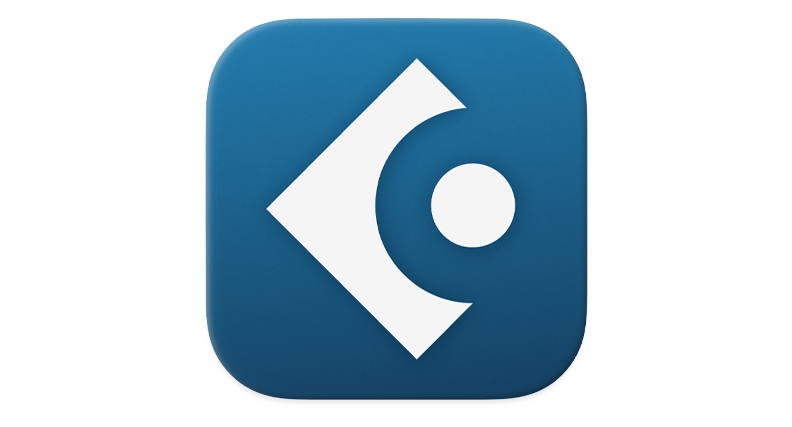
When it comes to digital audio workstations (DAWs), few names carry as much weight as Cubase. It’s been around since the end of the 80s and there’s a reason for that – it’s very, very good at what it does.
But as with all DAWs, no matter how good it is there is always scope for it to be expanded with new capabilities. That’s where plug-ins come in. VST instruments, synths, vocals… there’s plenty of options available.
But with so many VST plug-ins about, it can become easy to get lost trying to find the one best suited for your needs. And with both free and paid plug-ins available it can be hard to narrow things down.
Fortunately, our guide to the best free and paid for plug-ins for Cubase is here to help!
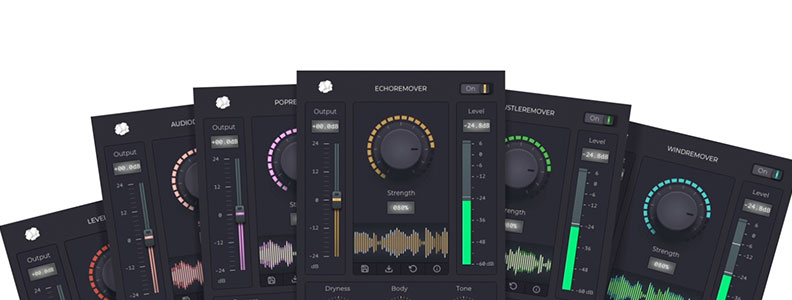
If you need any kind of audio restoration done, then the CrumplePop suite of audio restoration plug-ins is the way to go. Featuring a range of different plug-ins covering everything from echo reduction to traffic noise removal, there’s no better software for improving your sound quality.
Each VST plug-in can be used individually on your audio, so regardless of what you want to do, you can always have precise control over your sound.
The plug-ins are simple to operate so even beginners can get studio-quality audio restoration in no time at all. Simply adjust the central dial to apply the amount of correction you require and a few other settings to have more precise control to match your sound — that’s it!
And now, CrumplePop has a standalone SoundApp that allows you to apply all plug-ins to your audio at the same time.
This makes working with the plug-ins even more efficient as you can apply and adjust each one at the same time to achieve the best overall effect, rather than having to do it sequentially. The SoundApp is available for both Windows and MacOS operating systems.
Whatever your audio restoration needs, CrumplePop will have you covered.
Compatibility: VST3, AU, AAX

Many people assume that creating music electronically means putting stringed instruments to the side. The UJAM Virtual Guitarist puts this myth firmly to bed with a comprehensive plug-in designed to give you all the guitar riffage you could ever need, and then some.
There are over 350 different sampled phrases in the plug-in’s library, giving great flexibility to the style and genre of playing available. As well as pre-recorded phrases that can be used by anyone, even if you have never picked up a guitar before in your life, the Instrument Mode lets you play, strum, and record just as a guitarist would.
You can also vary between neck and bridge pickups just like a real guitarist would, giving you the chance to vary the tone and characteristics of your sound.
And there are more than 30 different stomp boxes available so you can customize the sound even further to ensure you have exactly what you need for your track.
The electric guitar has never been so accessible with the UJAM Virtual Guitarist — it’s simple to use, easy to pick up, and before long you’ll be rocking out and wondering how you ever made do without it. Few program files justify their place on your hard drive more than this one!
Compatibility: VST2, AU, AAX

Not everyone can be blessed with perfect pipes when it comes to singing. The Harmony plug-in from Waves is at hand to help you deal with any vocal processing you might need.
Using any kind of vocal correction or autotune software can be challenging, which is why the simplicity and ease of use of Harmony are much appreciated. A simple, uncluttered layout makes controlling your voice straightforward, and modifying pitch, tone, and other vocal aspects can be done quickly.
There are eight separate voices available in the plug-in. These sound natural and real, unlike other options, so you can always be sure your vocals will sound authentic.
The Harmony Generator allows you to stretch your creative side too by allowing you to develop harmonies and approaches that might not otherwise have been obvious. The plug-in isn’t just about correcting existing vocals, and the ability to add harmonies in this way makes Harmony stand out from the crowd.
The plug-in can also be controlled via MIDI, so you can easily get vocal samples and sounds cued up on a MIDI keyboard for the ultimate flexibility. This is especially advantageous in a live setting but however you want to use it, MIDI compatibility is a huge benefit for the plug-in.
Vocal tracks are one of the hardest things to get right when doing music production but the Harmonies plugin has made it that much easier — and at a very affordable price! It’s a great example of a paid plug-in that’s worth every penny.
Compatibility: VST, VST3. AAX, AU
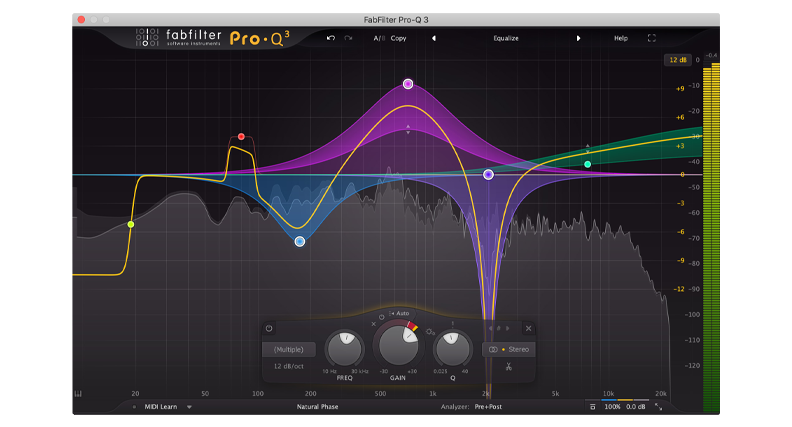
Getting your EQ right is vital to ensuring you have the best clarity possible in your music and that all your instruments don’t blend into one another. FabFilter gives you all the power you need for professional-level EQing and has plenty of other tools besides.
One of the most pleasing things about FabFilter is that it has a clean, easy-to-use interface and some great visualizations. Some EQ software can look like NASA mission control but FabFilter keeps everything accessible and easy to use. This helps keep the learning curve nice and low – you’ll be EQing in no time at all.
There are plenty of presets too, so if you’re in a hurry or even if you’re just a complete beginner, you can get great results in no time.
The software also supports full surround sound, including Dolby Atmos as well as stereo and mono, so whatever type of environment you need to EQ for will be covered.
The built-in spectrum analyzer is great and if you need to adjust a peak in real-time, all you need to do is grab it and go! It’s a really flexible solution and because FabFilter uses GPU processing it won’t kill your system, however hard you make it work.
FabFilter is a bit of a legend in EQing and it’s easy to see why it’s so widely used in the music industry. Worth every penny asked for!
Compatibility: VST2, VST3, AAX Native

Far from being just a free virtual instrument piano, the RGD Audio Free Piano 2 also acts as a string synth as well. Given that it’s free, the sound quality for both is great and the result is a flexible plug-in.
There are different mic positions for the piano to allow for different sound profiles and added flexibility in the way you want your piano to sound. That’s true for the strings as well, so you have plenty to play around with to create a suitable ambiance.
There’s also plenty of articulations available — over 400, in fact — so you can get fantastically authentic sounds. There are also different velocity settings to allow everything to sound more naturalistic and genuine.
The user interface is also clean, and clear of clutter and is worth mentioning simply because even professional developers get this wrong sometimes. Good interface design can make all the difference, especially with a free plug-in, and Free Piano 2 certainly comes up trumps in this.
If you’re looking to get started with piano and string sounds and you don’t want to pay a fortune for professional software, Free Piano 2 is a great place to start.
Compatibility: VST3, AU
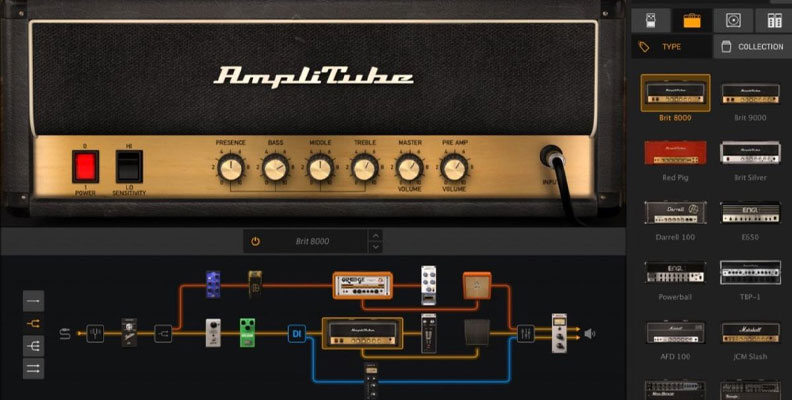
Whether you’re capturing a perfect live solo or recreating guitar using software, you’ll want to ensure you have exactly the sound you want. If you’re doing this in post-production, AmpliTube 5 is a great plug-in to have in your producer’s arsenal.
There are more than 400 models of equipment available in AmpliTube 5, so you’re bound to find an amp setup that’s exactly what you’re looking for. This includes 41 different cabinets, loads of effects and pedals, as well as amp heads.
The sound quality is really what makes AmpliTube 5 stand out. If you didn’t know these cabinets were software-emulated, you’d think it was the real thing. That sounds like hyperbole but it really is what makes AmpliTube worth getting.
The interface has also been cleaned up and generally improved and is now split into three different sections. Gear View lets you see what head amp you have in place as well as the controls for it, Gear Selector allows you to choose the equipment you want to use, and Chain lets you order the equipment in whatever setup you want.
If you’re serious about getting the best-sounding guitars possible, you really can’t go wrong with AmpliTube 5. The free version even lets you play around with the paid-for features, should you decide to upgrade!
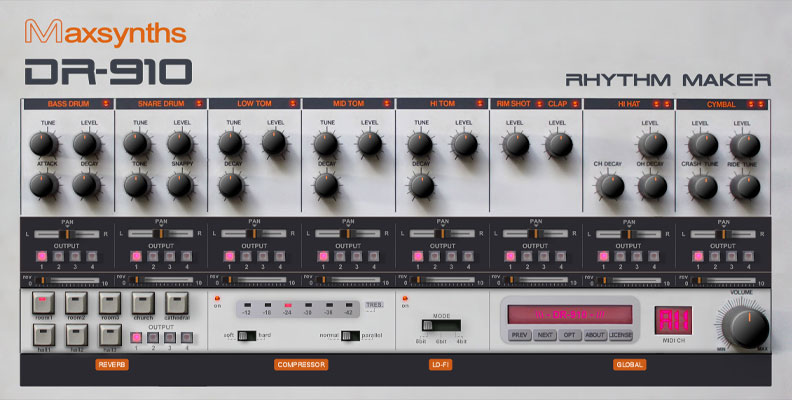
Need that classic Roland drum sound, but reluctant to pay a fortune for the expensive plug-in versions or the even more expensive physical hardware? Then look no further than the DR-910 from MaxSynths.
Each section of the iconic Roland DR-910 is emulated here individually, which results in a remarkably authentic sound. The original unit is expanded on a little too, so there are mixing effects here that weren’t present in the origin.
These include reverb, compression, and a “lo-fi” setting. This allows for plenty of mixing within the plug-in itself, rather than having to use your DAW to achieve the same effect.
Aside from that, though, all the original controls are present and correct and you can have endless fun recreating classic sounds and developing them for your own projects.
MIDI support is also completely integrated via MIDI CC# so you have added flexibility in the way you use the plug-in.
If you need to recreate a classic drum sound without having the budget of a full recording studio then the MaxSynths DR-910 is the answer to your prayers.

Guitar players might hog all the glory but bass players are just as vital a part of any band. And with the Ample Bass P Lite II, you can be assured of some great-sounding bass lines to anchor your tunes to.
The captured samples are based on the Fender Precision bass, the first bass guitar ever mass-marketed, whose legacy goes back to the 50s. It’s probably the most played guitar in history.
This iconic sound is captured perfectly in the Bass P Lite II, with great-sounding samples that really belie the free nature of the plug-in. The sound quality is as good as many far more expensive bass emulators so you know you’re getting top-quality bass sounds as a result of using this.
There’s plenty of articulation available as well, so you can add hammer-ons, pull-offs, accents, and sustain to your compositions. These are simple effects but make all the difference.
There’s also the option to customize parameters to give you more versatile control of your sound, and of course, you can combine different articulations to get something that really sounds unique.
If learning the bass isn’t something you have the time for, the Bass P Lite II could be the perfect way to add bass to your songs. It’s free, it sounds great for a virtual instrument, and it won’t drag your system to a standstill while being used. You can’t go wrong!
Compatibility: VST2, VST3, AU, AAX, standalone host.
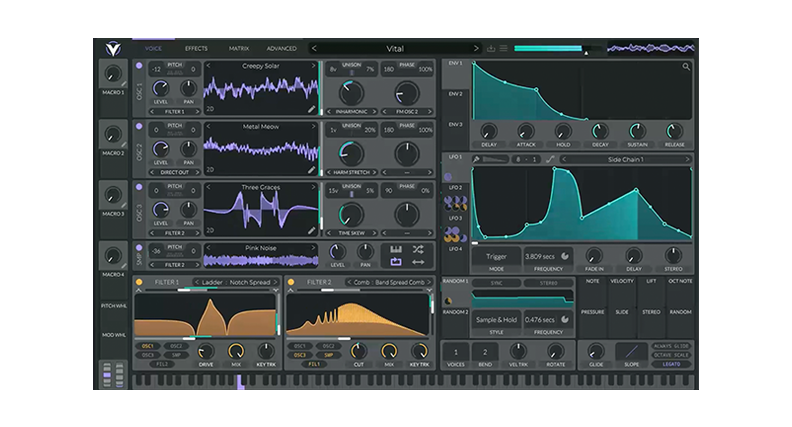
Wavetable synths are an incredibly versatile, detailed way of creating unique sounds, tones, and melodies for your projects. The Vital Wavetable Synth gives you all the control and power you need for your sound design.
What makes this plug-in stand out is that it’s perfectly put together for the creation of new sounds as well as working on existing wavetables. This adds to the flexibility of the wavetable synth, and it has a big range of effects.
Microtonality, text input, vocoder effects, and pitch slicing are all handled effortlessly – upload your audio file and you are good to go. The plug-in’s warping oscillator is particularly powerful and makes sure that every harmony you need can be sculpted to your precise desires.
The plug-in also comes with MPE support, so if you own a Linnstrument or other compatible piece of hardware, you’ll have full control and support from the plug-in.
Although the layout isn’t the simplest, which means the plug-in does come with a learning curve, the benefit of this is the power that the wavetable synth has. There really is pretty much nothing it can’t do – sound designers will love it!
There are many plug-ins out there, both free and paid, that give you the opportunity to expand what Cubase is capable of. Whether you need virtual instruments, a synth, or tools to help you in post-production, there is something out there for everyone.
Just launch Cubase, make your choice, load it up, and get going!